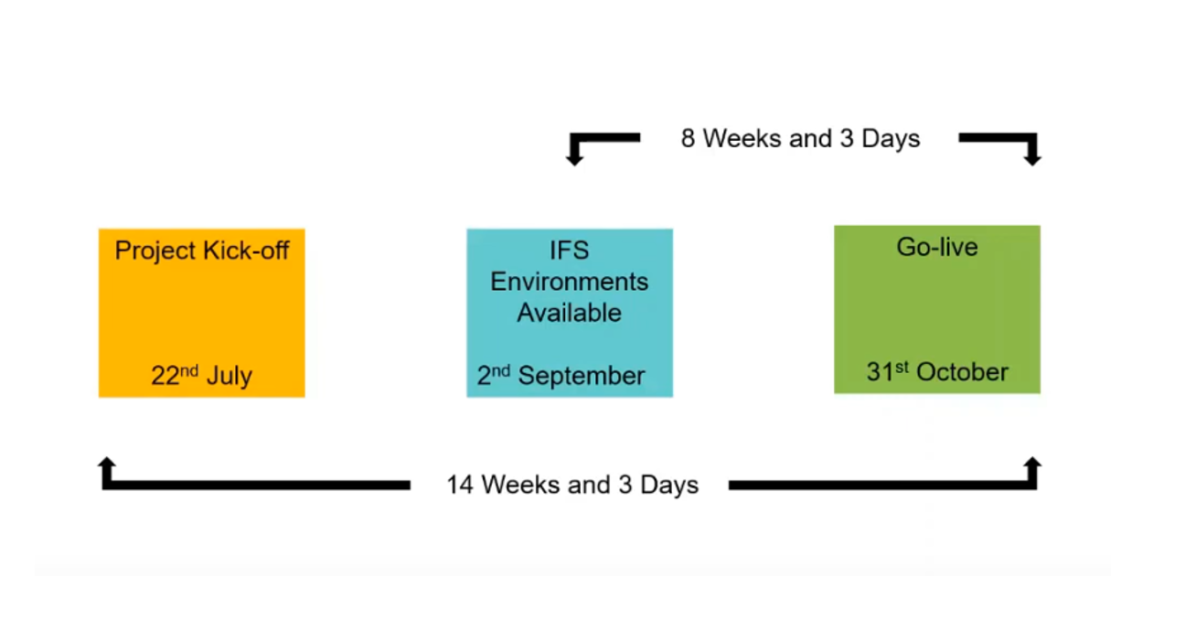Andrew Wright, IFS Manager at Flatfish and Caistor Seafoods, explains how, in under 12 weeks, his team—with the help of IFS Gold Channel Partner Vanilla—got IFS Applications 10 live from scratch, before successfully upgrading an instance of IFS Applications 7 to IFS Applications 10.
Sometimes in IT, life really throws you in at the deep end. And this time it was my turn.
‘Your mission, should you choose to accept it: a major investment will see your company turnover triple in the next 12 months. You have 16 weeks to reach go-live with IFS Applications 10, from scratch, replicating core business processes. Oh, and while you’re at it, upgrade another business unit from IFS Applications 7 to IFS Application 10 after that.’
To explain the business context that led to this scenario, I’ll share a little background.

From family business to international player
Flatfish Ltd began as a small father and son business in 1979, supplying fish such as plaice, lemon sole and turbot to UK companies including Caistor Seafood. Steady growth and a major regeneration project created a state-of-the-art processing and filleting plant in Grimsby, UK. We supply quality, sustainably sourced fresh and frozen products with full traceability and provenance.
In 2017 the European arm of Japanese global fishing conglomerate Nissui Europe took over Caistor Seafood and, in 2019, also took a 75% stake in Flatfish. A strategic decision to move all processing to our Flatfish facility in Grimsby followed, expanding and upscaling the site with a £2m investment.
From an IT perspective, the challenge was daunting. Turnover at Flatfish was expected to rise from £12m to approximately £40m within a year, with hundreds of new products and fish species joining the inventory. The legacy system at Flatfish would not offer us the capability we needed, whilst our Caistor Seafood operation was using IFS Apps 7—well behind the current IFS Applications 10. We had a 16-week project window to move all production and systems from Caistor Seafood to the new Flatfish facility being built; I questioned whether it was even conceivable to consider implementing IFS within this timeframe.
Most IFS installations I’d seen were typically 6 to 9-month programs. Having worked with IFS Gold Channel Partner Vanilla in the past, I consulted their team, who, incredibly, devised a plan to deliver the program in 15 weeks! Their technical services team rapidly mapped out the likely structure required and helped us make key decisions such as hosting IFS in the cloud, instead of on-premise.

Data dilemmas
The first five weeks or so saw us focus on understanding and preparing data feeds; but, since Flatfish was a new project, we did not know what data would be needed. So, since any new operation would be similar to the former Caistor Seafoods setup, we decided to replicate those business processes. By using templates to consistently populate the new data for Flatfish, in 8 weeks we had live data up in the cloud and could start developing our IFS solution. Vanilla was able to bring tools and approaches to the project that helped us really reduce project timescales.
The IFS Applications functionality we brought across included IFS Financials (General Ledger, Fixed Assets, Accounts Payable, Accounts Receivable, and EDI e-invoicing); IFS Manufacturing (Shop Order, Costing, MRP); Distribution (Inventory, Customer Orders, Purchasing and Invoicing); and Engineering & Product Design. With customers including national chains such as Tesco, Waitrose and Ocado, we used EDI API supplier NeTIX to link to IFS with help from partner Vanilla. The NeTIX API automatically brings any message from IFS into the required online customer format.
To put the timeframe in perspective, the diagram shows just how rapidly the project came together.

Loading a system with data, testing and going live within 8 weeks and three days is an extraordinary achievement by any measure. Looking back on our journey, we learned some useful lessons, which I’ll gladly share.
#1 Changes: Consider the wider implications of any changes across the business
We had a lot of part codes for Flatfish and Caistor that would have overlapped. So, we changed them before we realized our new codes didn’t carry any meaning. Now we have codes that people can understand. For instance, FF codes indicate finished products for Flatfish, whereas FC indicates a code for Caistor Seafood.
What we also didn’t factor in was that our legacy codes also appeared on documentation like factory specifications and supplier specifications. To compound matters, Flatfish generates a lot of products upfront, which meant that our cold stores still held stock marked with the old codes, creating some confusion with customers.
Next, because Nissui had a special way of reporting, we thought it would be logical to change the chart of accounts to mimic this. This created considerable additional work to enable Caistor and Flatfish reporting to marry up when they both had to do their quarter and month-end reporting. In summary, it pays to carefully think through the wider business implications before making any changes.
#2 Resources: Ensure you have sufficient resource to run the project
As I mentioned earlier, Flatfish grew from a very small family company, so spare resource wasn’t available to manage a project like this. Ultimately, although most of the project was seen through by me, a single colleague and our partners Vanilla, the pinch points came when we needed to secure the availability of staff—for example for system testing or to attend training. So do make every effort to get all the resources you can, because you will need spare capacity to achieve go-live. In the current IFS project for Caistor, we now have a team of about 12 people in place.

#3 Training: Train everyone, consistently, in the same way
Although we took around 30 staff from Caistor across to Flatfish, all of whom had been using IFS, we didn’t anticipate that some inconsistent practices might come with them. We leaned that to ensure consistency going forwards, it’s far better to ensure that everybody is trained in the same way. Over time IFS users can find system shortcuts, but they rarely reflect the correct way to use the system: proper training can address that and prevent bad habits. I would also check that all training material is consistent across all users.
#4 Parallel running: Never, ever parallel run
As we changed the chart of accounts in IFS, Flatfish wanted us to ensure that they had a full year of accounts left in the legacy software. Against our recommendation, we complied, but the two systems are totally different. It proved a very difficult and time-consuming job doing each step twice with limited resources. All the shop orders and purchase orders had to go into one system and then be duplicated and entered into the other. Never agree to run in parallel!
#5 Confidence: Remember that users will adapt
It’s probably true to say that as far as Flatfish was concerned, the prospect of moving from the existing legacy software to IFS was daunting at the outset. Our decision to move to a new system was sudden, with a short, fixed timeline. To their credit, the team embraced the changes and challenges.

Looking ahead
The Flatfish implementation of IFS Applications 10 resulted in a go-live in October 2019, a parallel run until December, and then exclusive use of IFS Applications 10 on January 1, 2020. With that project complete, we’ve now upgraded the system at Caistor Seafoods, re-implementing the solution from IFS Applications 7 to IFS Applications 10.
These transitions have met our business goals. With wet fish production now with Flatfish, Caistor Seafood can focus on being a coating plant; apart from part codes and core data like the suppliers and customers, we haven’t needed to migrate anything else. Caistor Seafood went live with basic data in May 2020, with a full IFS Applications 10 system upgrade operating since July 1.
And so, while it’s ‘Mission Accomplished’ for the moment, we’re not stopping yet. We’re now looking ahead to introducing IFS document management across both businesses.
Considering an IFS Applications upgrade? Visit the IFS Applications customer page to learn more.
Do you have questions or comments?
We’d love to hear them so please leave us a message below.
Colin Elkins
Great Blog and a great achievement